2013 Review of Spectroscopic Instrumentation Presented at Pittcon
Our annual review of products introduced at Pittcon.
As usual, there was concern at the 2013 Pittcon show about how well the conference is doing. Also as usual, we can only go by the figures. The final attendance was 18,197, as compared to the final 2012 attendance, which was 15,754, so it appears that Pittcon is responding to the recovery of the economy, as it did to the recession. A breakdown of the attendance by attendee type, and comparison with previous Pittcon events is found at http://www.pittcon.org/exhibitor/exhibiting-at-pittcon.
A somewhat more detailed list of exhibitors is available in the Excel spreadsheet at: http://pittcon.org/wp-content/uploads/2012/10/2013-pcvb-list-for-website.xls. From this list we find that there were 3586 total companies present.
A different indication of the amount of activity is the number of exhibitors of spectroscopic instrumentation. This is somewhat difficult to pin down. Most listings of company types include companies providing other types of instruments (such as chromatography) as well as spectroscopic devices. I attempted to circumvent that by using the product locator and entering the various types of spectroscopic instrumentation, which then caused the product locator to respond with the number of companies found under that category. This is still a far-from-perfect way to count companies, because several of them are included in more than one category, while some, even though present, were not found in any of the categories I searched in the product locator. Furthermore, a listing under a given category does not mean that the company manufactures instruments; it might make accessories, software, standards, or something else related to that technology. In addition, more-general categories such as software, accessories, and components inevitably include those for other technologies as well. Nevertheless, this is the method I used for what I consider the major categories. Here are the results (in descending numerical order):
Accessories: 239
Mass spectrometry: 135
Software: 113
UV–vis: 95
Mid-IR: 89
Near-IR: 66
Components: 60
X-ray: 54
Raman: 52
NMR: 27
ESR: 5
Of course, this listing contains far too many companies for me to have visited them all. I was able to contact and get information from only a small fraction of the companies listed above. I can only hope that I didn't miss the ones with the most worthwhile new offerings.
As we have noted in previous years, some of the large, previously stalwart, instrument companies were again notable by their absence from Pittcon, or presence in only a nominal way. Countering that effect were many new small exhibitor companies (completely new, or new to Pittcon). By most accounts, these smaller companies are the source of most innovation in any technology, so the attendance figures are not the whole story. I try to find all of those new companies to include here, because nurturing new small companies is an important function of such things as this review (and of Pittcon itself, to be sure).
We are also pleased to note that a spectroscopy company is among the winners of the Editor's Choice awards this year. Pie Photonics tied for third place and shares the Bronze Medal for their passive (no moving parts) interferometer engine. It turns out that all the winning companies were startup, first-time-at-Pittcon companies. I suppose this is some validation of our statement above that small startup companies seem to be the most innovative.
Over the years, long-time attendees note the arrival and departures of "fashions" in the instruments and booths seen. At Pittcon 2012 we saw the start of the next new trend in instrumentation: the incipient use of cell phones and tablet computers as the controlling devices for the instrument. We believe this trend will only continue in the future.
As usual, our extended listings indicate whether a given instrument is for the laboratory (that is, a fixed location), for process applications, or portable or handheld; we also include, for several instruments, especially the ones that are portable or transportable, their size or weight, or both. This information can provide the reader with a more precise idea of just how portable a given unit is.
As noted, the trend toward decreasing instrument size and increasing presence of smaller instruments is still continuing. The need for such instruments seems unlikely to abate, and "robot transportable" also seems to be coming in vogue.
As usual, I organized this review according to the wavelength region and type of spectroscopy involved (such as mid-IR, X-ray, UV–vis, Raman). We tried to arrange it so as to allow readers to easily compare instruments from different manufacturers, even though it may sometimes lump together instruments of the "good enough is OK" type with ultraprecise laboratory designs.
The advances a company makes from one year to the next are often not obvious, or even visible (especially for the software, but often even in hardware, too). For this reason, we asked the exhibitors to tell us exactly what new changes they introduced this year, so that we could, in turn, tell our readers about them. Therefore, we will note the changes each company made, and what is new in their current offerings, compared to previous models, or new versions of a continued model.
The categories we used in this review to classify the instruments (in alphabetical order) are the same as those we used in last year's review, and are as follows:
Accessories
Atomic Spectroscopy
Components
Fluorescence
Imaging
Mass Spectrometry
Mid-IR
NIR
NMR
Raman
Software
Terahertz
UV–visible
X-ray (which includes all shorter-wavelength methods, if present).
Also as usual, it is inevitable that some categories include products from companies that might arguably also be classified under one of the other categories. These categories are accessories, components, imaging, and software. For example, a Raman imaging spectrometer might be found under "Raman" or "Imaging." Similarly, for "hyphenated" techniques, such as inductively coupled plasma–mass spectrometry (ICP-MS), the reader may need to check either category (at least one ICP-MS instrument is included under atomic spectroscopy). I try to be consistent, but can't guarantee perfection. Therefore, if a product is not found in an expected category, others should be checked. Another holdover is the index (Table I); if you know the name of a company you want to find, it will tell you under what heading or headings you will find it. Some companies, with products based on multiple technologies, will have multiple entries, but then presumably you know which type of instrument you're looking for.

Table I: Index of companies mentioned in this article.
This year we continue the splitting of the review between the hard copy version and the on-line version of the review, which will be accessible at www.spectroscopyonline.com/Pittcon2013. In this hard-copy version of the review, all products are listed in a summarized fashion in the tables, which highlight key applications, features, or benefits. The on-line version includes a series of appendices that include more detail about each product.

Table I: Index of companies mentioned in this article (continued)
ACCESSORIES
The accessories category (Table II) is our largest category this year, with 29 entries. It includes a wide range of products, in terms of wavelength coverage (X-rays to terahertz and microwaves), in terms of size and weight (from minifiber couplers to large sample-handling accessories), and in terms of power requirements (from USB-powered devices to almost 2-kW magnetrons. Thus, it is virtually impossible to describe any overall trends in this category. A quick review of the table, however, will tell you what is new.

Table II: Accessories

Table II: Accessories (continued)

Table II: Accessories (continued)
ATOMIC SPECTROSCOPY
All the companies listed here (Table III) have improved capabilities, such as higher-speed analysis and better sensitivity. For example, Bruker's instrument offers improved performance. The Nippon Instruments analyzer provides full automation of the sample digestion and analysis. TSI Incorporated now has software providing easier quantification and calibration. Both Brooks Rand Labs and Milestone sought to facilitate use by developing systems for mercury analysis according to methods from the U.S. Environmental Protection Agency; Brooks Rand's instrument is also modular.
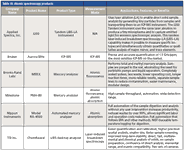
Table III: Atomic spectroscopy products
Two instruments in this category can handle more than one type of analysis. Applied Spectra's instrument offers laser ablation–inductively coupled plasma–mass spectrometry (LA-ICP-MS) and laser-induced breakdown spectroscopy (LIBS) analysis in a single instrument, and Milestone provides simultaneous atomic absorption and atomic fluorescence spectroscopy.
COMPONENTS
The components category (Table IV) is as varied as the accessories section. Different products have different characteristics that are applicable to that type of product. These listings, therefore, should consider each manufacturer's products on its own merits, and no attempt should be made to compare different manufacturers' products when they are based on different criteria.
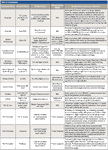
Table IV: Components
So what's the difference between a "component" and an "accessory"? In my classification of products, a component is something that can be used in the construction of an instrument and becomes an inherent part of it: If it's not there then the instrument will not work, or at least will be severely degraded. An accessory is a device that can optionally be used in conjunction with an instrument and is generally external to it; the instrument will work just fine without it, but the accessory extends the capabilities — such as a liquid flow cell for an instrument innately designed to measure solid samples. The accessory can be removed to return the instrument to it's previous performance level, whereas a component generally cannot be removed except by a factory-trained expert.

Table IV: Components (continued)
FLUORESCENCE
Horiba Scientific's new offering in this category (Table V) is a simple-to-use filter-based system, with the added benefit of fast measurement.

Table V: Fluorescence
IMAGING
This year, we have just one new instrument in the imaging category (Table VI): a UV–vis and Raman imaging spectrograph from Princeton Instruments, with high resolution. The manufacturer says it offers practically perfect optical aberration-free imaging with zero field astigmatism and greatly reduced coma and spherical aberration.

Table VI: Imaging
MASS SPECTROMETRY
This category (Table VII) of instrumentation is probably one of the best examples of how, even within a single category of instrument, different design choices lead to instruments with different characteristics. The variety of different technologies to distinguish ions of different masses contributes to this variety of instruments, making it hard to compare instruments or discern trends in this category.
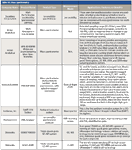
Table VII: Mass Spectrometry
Manufacturers in this category are offering a variety of products and features. Excellims has a hyphenated high performance liquid chromatography–ion mobility system (HPLC–HPIMS) that provides two-dimensional separation. Hiden Analytical provides an extended sampling pressure range from 10 mbar to 30 bar. Ionicon has updated its instrument by making Kr+ and Xe+ available as reagent ions for proton reaction transfer-MS. IonSense has the first ambient ionization system for a gas chromatography–mass spectrometry (GC–MS) instrument. Photonis USA has combined its patented "Resistive Glass" products with a new robust ion gate technology. Shimadzu has new triple-quadrupole instruments for GC–MS-MS and LC–MS-MS.
MID-INFRARED (MID-IR)
Mid-IR spectroscopy (Table VII), for which "FT-IR" is a commonly used synonym, also includes instruments that are based on other technologies. Fourier transform spectroscopy is also used in other spectroscopic fields, but here is where the oldest and most mature manufacturers do not tout the "specsmanship" (which we eschew in this review, anyway) of their underlying technological "engines" because wavelength scales for all instruments are controlled by laser-fringe-referencing, and the noise and signal-to-noise characteristics are limited by the detectors. Not that all instruments are the same — different design decisions on the part of manufacturers still give a variety of choices users need to make.
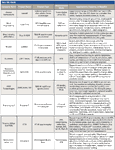
Table VIII: Mid-IR
We are pleased to note that the founder of Pyreos Systems won this year's Williams-Wright award. The award session highlighted the miniature spectrometers Pyreos developed.
This year's products include various new features. Anasys offers a new IR source with a larger laser tuning range. Block Engineering has the widest tuning range of any off-the-shelf mid-IR source. Blue Industry and Science has a new multipurpose mid-IR gas analyzer for real-time measurements of trace gases. Bruker's FT-IR spectrometer and microscope is designed to combine top performance for visible inspection and infrared spectral analysis with ease and comfort. In the Durasens instrument, sample temperature control is integrated into the hardware and software. Newport's new FT-IR spectrometer is modular, so detector, source, and sample component can be switched as needed.
PAIR Technologies offers acquisition of spectra at >1000 scans/s. Precisive provides real-time, on-line hydrocarbon composition monitoring. Thermo Fisher Scientific offers one-touch switching between multiple experiments. Wilks Enterprise has improved its electronics and provided an intuitive touch-screen display.
NIR
NIR spectrometers (Table IX) are on the forefront in pursuing small size and low-power operation. Indeed, a number of this year's products feature aspects that make them more portable, modular, or affordable. Such offerings include a cordless NIR spectrometer (JDS Uniphase); a wide variety of modular sensor heads (Polytec); on-board data processing and USB 3.0 communication (B&W Tek), a low-cost filter photometer with 400–2150 nm coverage (Guided Wave), and a design optimized to minimize the complexity associated with process equipment implementation (ABB Analytical Measurements). FITNIR Analyzers, in turn, has developed a benchtop version of its on-line near-infrared analyzer.
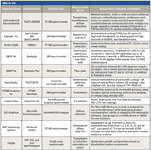
Table IX: NIR
New to BaySpec's instrument is a highly efficient volume phase grating and an ultrasensitive InGaAs array detector. NIR Technology Systems's new FT-NIR instrument has a rotating sample dish to measure a large area of sample. EssentOptics provides an instrument specifically designed to measure thin film coatings.
NMR
Magritek says that its compact NMR spectrometer (Table X) is the fastest and has the highest resolution and sensitivity of any compact NMR spectrometer on the market.

Table X: NMR
RAMAN
In this category (Table XI), manufacturers are touting a range of new features, some focused on portability and versatility, and others on resolution and spectral range.
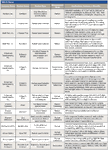
Table XI: Raman
In terms of the former, Enhanced Spectrometry has the first handheld instrument acquiring and analyzing both Raman spectra and luminescence. Enwave Optronics has a new design for higher sensitivity and lighter weight. Real-Time Analyzers is offering a portable fuel analyzer for diesel and jet fuels. Snowy Range's Raman system has 532-, 638-, 785-, or 808-nm excitation. B&W Tek offers a 1064-nm laser in a portable Raman spectrometer. Horiba provides one-shot functionality from acquisition to reporting. Tornado Spectral Systems's product is factory configurable from UV–vis to NIR.

Table XI: Raman (continued)
In terms of manufacturers focusing on performance, BaySpec's instrument is now available with ultrahigh ~5 cm-1 resolution over the full 200–3200 cm-1 spectral range at the 1064-nm excitation wavelength. Ocean Optics has a high throughput virtual slit design.
SOFTWARE
Every instrument manufacturer of necessity provides software (Table XII) for its own instrument so that users can take their data, or their results, out of the instrument. One type of software described here is portable, meaning programs that can be run on any computer of the correct type. The other type of software listed here includes compilations of spectral data.

Table XII: Software
A few entries in this category warrant special mention this year. ACD/Labs has a new powerful databasing system. Bio-Rad Laboratories offers enhanced ability to visualize results from simultaneous searches. Fiveash Data Management has a new library of 340 dye spectra. Renishaw now supports massive Raman datasets containing millions of spectra. Shimadzu and Integrated Analysis both offer a turnkey, secure software package. And Symbion Systems has a brand new chemometrics product.

Table XII: Software (continued)
TERAHERTZ
The terahertz products (Table XIII) listed here are all imaging devices, so they could have been included in the imaging section, but it seemed worth grouping them here.

Table XIII: Terahertz
The system from Advantest has a new polarization accessory, an extended range spectrometer option, a subterahertz spectrometer option, and new emitter and detector modules. BrightSpec is a brand new company, offering a gas-phase analyzer and a rotational spectrometer for subterahertz gas-phase analysis. Both are said to provide ultrahigh resolution and zero or near-zero background.
UV–VIS
Tornado Systems has a unique technology this year in its UV–vis (Table XIV) system: optical coherence tomography (OCT). This is similar to X-ray tomography used in medical applications, but uses light and is designed for industrial applications.
EssentOptics has a product with an expanded spectral range of 19–4000 nm and average polarization measurement. Filmetrics boasts that has the simplest spectral reflectance and transmittance system available. Horiba says they offer the world's fastest spectrofluorometer, which can simultaneously measure both absorbance and fluorescence spectra. Laxco has an expanded product line of cell density meters.
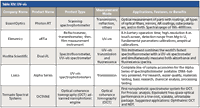
Table XIV: UV-vis
X-RAY
Unlike last year, this year we have enough X-ray products for a standalone table (Table XV). This is also the first year we've had a product to detect and measure radiation shorter than X-rays: S.E. International is providing a gamma-ray detection system.
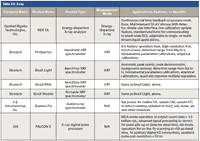
Table XV: X-ray
Applied Rigaku Technologies has a new product line of energy dispersive X-ray analyzers, and Elvatech has a range of X-ray fluorescence spectrometers of different sizes. XIA offers extremely high count rates.
APPENDIXES ON-LINE
Additional product details appear on-line in the appendixes, at:
Appendix I: Accessories
www.spectroscopyonline.com/view/Accessories2013
Appendix II: Atomic spectroscopy
www.spectroscopyonline.com/view/AtomicSpectroscopy2013
Appendix III: Components
www.spectroscopyonline.com/view/Components2013
Appendix IV: Fluorescence
Appendix V: Imaging
Appendix VI: Mass spectrometry
Appendix VII: Mid-IR (FT-IR)
Appendix VIII: NIR www.spectroscopyonline.com/NIR2013
Appendix IX: NMR www.spectroscopyonline.com/NMR2013
Appendix X: Raman www.spectroscopyonline.com/Raman2013
Appendix XI: Software www.spectroscopyonline.com/Software2013
Appendix XII: Terahertz www.spectroscopyonline.com/Terahertz2013
Appendix XIII: UV–vis www.spectroscopyonline.com/UV-vis2013
Appendix XIV: X-ray www.spectroscopyonline.com/X-ray2013
Howard Mark serves on the Editorial Advisory Board of Spectroscopy and is a regular coauthor of the "Chemometrics in Spectroscopy" column. He also runs a consulting service, Mark Electronics (Suffern, New York). He can be reached at hlmark@nearinfrared.com
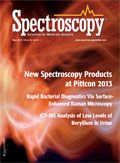
New Raman Spectroscopy Method Enhances Real-Time Monitoring Across Fermentation Processes
April 15th 2025Researchers at Delft University of Technology have developed a novel method using single compound spectra to enhance the transferability and accuracy of Raman spectroscopy models for real-time fermentation monitoring.
New Multi-Spectroscopic System Enhances Cultural Heritage Analysis
April 2nd 2025A new study published in Talanta introduces SYSPECTRAL, a portable multi-spectroscopic system that can conduct non-invasive, in situ chemical analysis of cultural heritage materials by integrating LIBS, LIF, Raman, and reflectance spectroscopy into a single compact device.